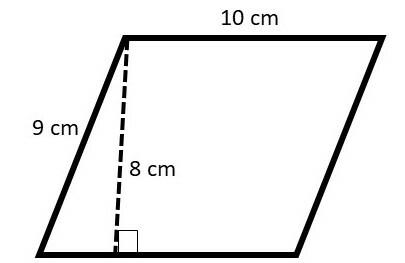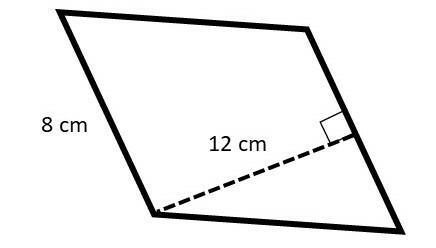You parallelogramsthey are polygons four-sided, which have opposite sides parallel, two by two. Examples of parallelograms are: o square, O rectangle it's the diamond.
The area (A) of any parallelogram corresponds to the measure of its surface and can be determined by the following formula:
On what:
- B: measure of the base of the parallelogram;
- H: height of the parallelogram.
To learn more about this subject, check out a list of exercises on the parallelogram area, with all resolutions of the issues.
Index
- Exercises on the area of parallelograms
- Resolution of question 1
- Resolution of question 2
- Resolution of question 3
- Resolution of question 4
Exercises on the area of parallelograms
Question 1. Determine the area of the parallelogram with the dimensions shown in the figure below:

Question 2. Determine the area of the parallelogram with the dimensions shown in the figure below:

Question 3. Determine the colored surface area of the figure below:

Question 4. Determine the area of the parallelogram with dimensions shown in the figure below:

Resolution of question 1
We have b = 10 cm and h = 8 cm. Let's substitute these values into the parallelogram area formula:
Therefore, the parallelogram area is equal to 80 cm².
Resolution of question 2
We have b = 8 cm and h = 12 cm. Let's substitute these values into the parallelogram area formula:
Therefore, the parallelogram area is equal to 96 cm².
Resolution of question 3
The colored surface area corresponds to the area of the major parallelogram minus the area of the major parallelogram.
Let's calculate the area of each parallelogram separately.
Larger parallelogram:
We have b = 7 cm + 2 cm = 9 cm and h = 10 cm + 1 cm = 11 cm. Let's substitute these values into the parallelogram area formula:
- Free Online Inclusive Education Course
- Free Online Toy Library and Learning Course
- Free Online Math Games Course in Early Childhood Education
- Free Online Pedagogical Cultural Workshops Course
Minor parallelogram:
We have b = 7 cm and h = 10 cm. Let's substitute these values into the parallelogram area formula:
So, the colored surface area is given by:
Therefore, the colored surface area is equal to 29 cm².
Resolution of question 4
To calculate the area of the parallelogram, we need to determine the measure of its base, that is, the measure of the side. .
Notice that .
Also, see that it is one of the legs of a right triangle, whose hypotenuse measures 13 cm and the other leg measures 12 cm.
So, by the Pythagorean theorem, We have to:
Now, by the height theorem, we have to:
We can already determine the measure of the base of the parallelogram:
Finally, we calculate your area:
Therefore, the parallelogram area is equal to 405.6 cm².
To download this list of the parallelogram area in PDF, click here!
You may also be interested:
- circle area
- trapeze area
- Triangle Area
The password has been sent to your email.
